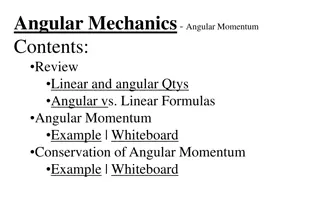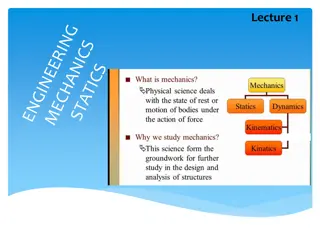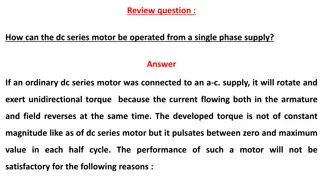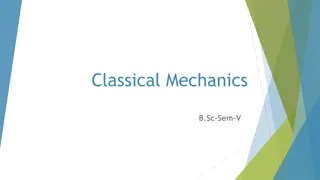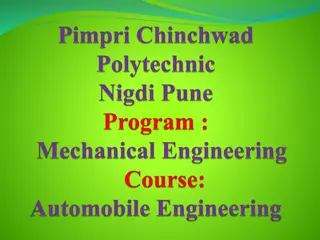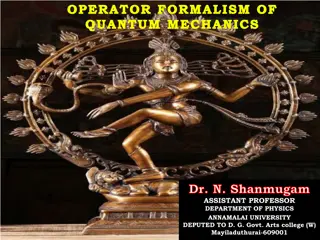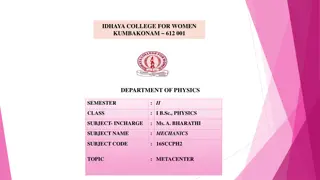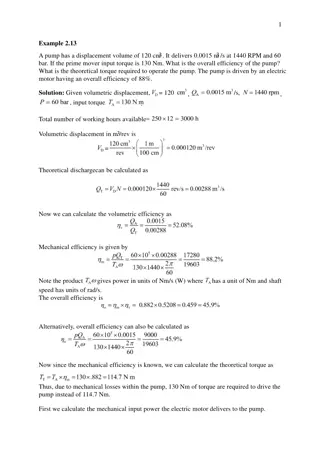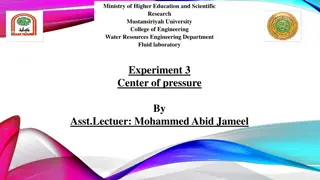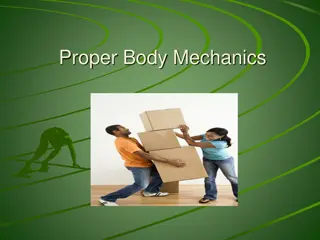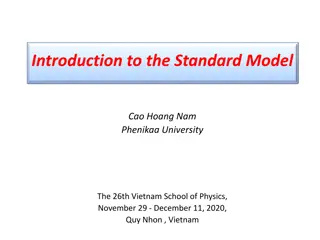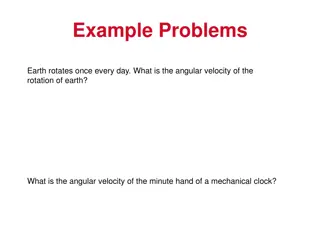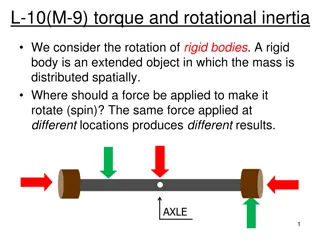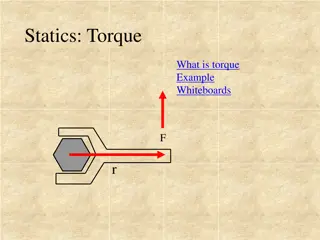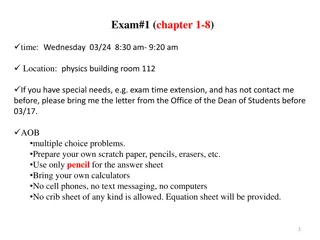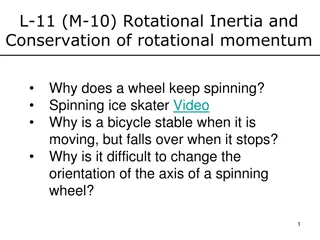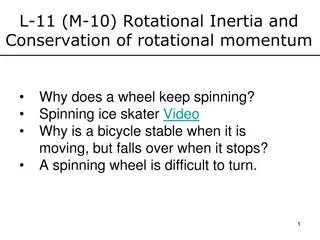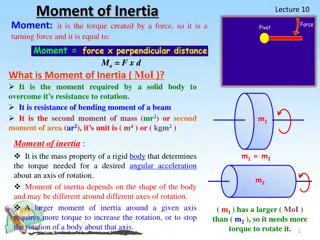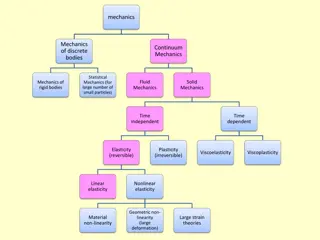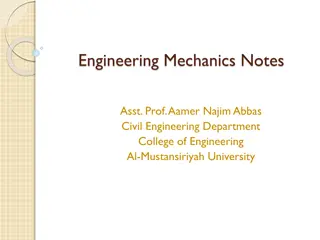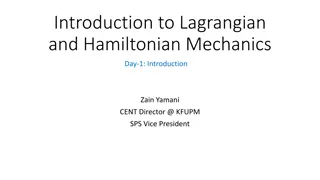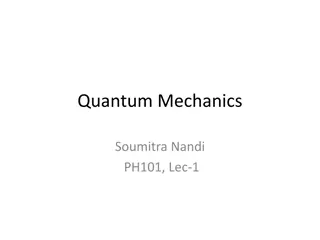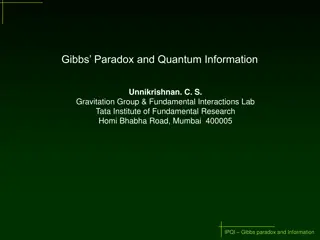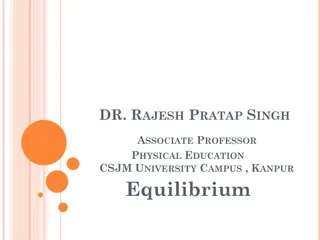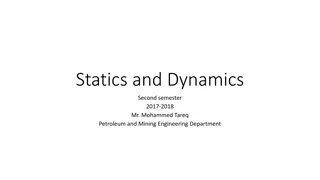Understanding Angular Momentum in Mechanics
Explore the key concepts of angular momentum in mechanics, including the difference between linear and angular quantities, angular momentum calculations, conservation principles, and practical examples illustrated on whiteboards. Delve into formulas, equations, and scenarios to grasp the fundamental
4 views • 27 slides
Angular Mechanics - Angular Momentum Concepts and Examples
Understanding angular momentum in mechanics involves reviewing linear and angular quantities, comparing angular to linear formulas, and exploring examples of angular momentum and conservation principles. The content covers key factors like angular quantities, torque, and moment of inertia, along wit
3 views • 23 slides
Overview of Fluid Mechanics: Branches, Flow Types, and Equations
Fluid mechanics is subdivided into three branches: Fluid Static, Kinematics, and Hydrodynamics. The study of fluid flow includes different types such as uniform, non-uniform, steady, and unsteady flow. The motion of fluid particles obeys Newton's laws, and the conservation of mass and energy plays a
1 views • 4 slides
Fundamentals of Mechanics: Introduction to Basic Quantities and Units
Explore the foundational concepts of mechanics in this introductory lecture, covering basic quantities like length, time, mass, and force. Learn about idealizations, units of measurement, SI units, conversion of units, and prefixes used in the context of mechanics.
3 views • 7 slides
Operating a DC Series Motor from a Single Phase Supply
Connecting a DC series motor to an AC supply results in pulsating torque due to reversed current flow. This setup leads to inefficiencies and challenges such as eddy current losses and poor power factor. To improve performance, modifications like laminating core structures, using compensated winding
0 views • 23 slides
Understanding Classical Mechanics: Variational Principle and Applications
Classical Mechanics explores the Variational Principle in the calculus of variations, offering a method to determine maximum values of quantities dependent on functions. This principle, rooted in the wave function, aids in finding parameter values such as expectation values independently of the coor
0 views • 16 slides
Understanding Automobile Transmission Systems: Construction and Functions
Automobile transmission systems consist of components like the clutch, gearbox, propeller shaft, and differential, working together to transmit power from the engine to the wheels. The clutch engages and disengages power smoothly, while the gearbox adjusts torque and speed based on road conditions.
0 views • 22 slides
Understanding Operator Formalism in Quantum Mechanics
Dive into the world of quantum mechanics with Dr. N. Shanmugam as he explains the role of operators, their significance in quantum mechanics, and how they are used to determine physical quantities through expectation values. Explore concepts such as the Hamiltonian operator, time-independent Schrodi
1 views • 49 slides
Understanding Metacentre in Fluid Mechanics
Metacentre is a crucial concept in fluid mechanics, representing the theoretical point where a displaced body intersects lines passing through the centres of buoyancy and gravity. It is essential for analyzing the stability of floating bodies, especially ships. The metacentric height, the distance b
10 views • 15 slides
Pump Efficiency and Power Calculation Examples
This content provides detailed calculations for pump efficiency and power requirements in fluid power systems. It covers scenarios involving pump displacement, input torque, electric motor efficiency, volumetric and mechanical efficiencies, and power delivered to loads. The solutions include formula
2 views • 4 slides
Exploring Quantum Mechanics: Illusion or Reality?
Delve into the fascinating realm of quantum mechanics with Prof. D. M. Parshuramkar as he discusses the contrast between classical and quantum mechanics. Discover how classical mechanics fails to predict the behavior of electrons in atoms and molecules, leading to the development of quantum mechanic
0 views • 70 slides
Understanding Torque and Horsepower in Mechanics
In the world of mechanics, understanding torque and horsepower is essential. Torque, measured in pounds-feet, represents the rotational force exerted on an object, while horsepower, coined by James Watt, signifies the power output of a machine. By measuring torque and RPM, one can calculate horsepow
0 views • 7 slides
Exploring Neural Quantum States and Symmetries in Quantum Mechanics
This article delves into the intricacies of anti-symmetrized neural quantum states and the application of neural networks in solving for the ground-state wave function of atomic nuclei. It discusses the setup using the Rayleigh-Ritz variational principle, neural quantum states (NQSs), variational pa
0 views • 15 slides
Football Officiating Mechanics and Procedures
The detailed guide covers various aspects of football officiating, from pre-game preparation to on-field mechanics during scrimmage plays. It includes information on line of scrimmage protocols, pre-snap checklists, legal formations, and proper positioning during plays. The content emphasizes key re
0 views • 28 slides
Practical Guidance for Care Partners: Maintaining Healthy Body Mechanics and Mobility
This presentation offers practical advice for care partners on how to maintain healthy body mechanics, promote safe transfer and mobility techniques, and use mobility equipment effectively. It emphasizes the importance of being a healthy caregiver, staying strong and fit through appropriate exercise
0 views • 35 slides
Understanding the Center of Pressure in Fluid Mechanics Experiments
The concept of center of pressure in fluid mechanics is explored through experiments to find water pressure forces on surfaces immersed in water. Theoretical background equations for partial and complete immersion are provided, along with objectives related to determining water pressure forces and c
0 views • 13 slides
Umpire Clinic Takeaways and Field Mechanics Guide
Learn essential tips on what to wear, how to prepare, and key aspects of game time and umpiring mechanics. Explore insights on dealing with coaches and fans, understanding signals, and mastering field mechanics for both one and two-umpire systems. Enhance your skills in calling strikes and balls, ke
0 views • 41 slides
Proper Body Mechanics: Benefits, Causes of Injuries & How to Prevent Them
Body mechanics involve using the body efficiently to reduce strain and promote balance. Proper body mechanics can help conserve energy, reduce stress on muscles and joints, improve respiratory function, and prevent back injuries caused by factors like poor posture, bending, and twisting. Understandi
0 views • 20 slides
Understanding the Standard Model of Physics
Delve into the world of quantum field theory, gauge symmetry, Higgs mechanism, electroweak theory, and more with this detailed overview of the Standard Model. Explore classical mechanics, Noether's theorem, relativistic mechanics, quantum mechanics, and quantum field theory concepts. Discover how th
1 views • 21 slides
Understanding Tug of War Battle Bots: Concepts of Gear Ratio and Torque
Explore the exciting world of Tug of War Battle Bots where teams design vehicles for maximum pulling power. Learn about friction, torque, and gear ratio while modifying robots to compete in a thrilling tug of war challenge. Discover how gears, motors, and physics concepts play a crucial role in opti
0 views • 16 slides
Understanding Angular Velocity, Torque, and Conservation of Angular Momentum in Physics
Earth's angular velocity, minute hand rotation, torque calculations, application of torque in balancing seesaws, motion equations, and car deceleration scenarios are explored. Concepts like rotational inertia, kinetic energy, and conservation of angular momentum are discussed, providing a comprehens
0 views • 6 slides
Introduction to Statistical Mechanics and Quantum Mechanics
In statistical mechanics, quantum mechanics teaches us that all systems have discrete energy levels. By examining ensembles of atoms or molecules with different energy levels, we can understand probabilities, thermal equilibrium, and average energy using Boltzmann's postulate and the partition funct
0 views • 5 slides
The Logical Structure of Classical and Quantum Mechanics
The paper explores the common logical structure shared between classical and quantum mechanics, emphasizing the non-distributive lattice embedded in a distributive one. It discusses how all physical theories must adhere to this structure, incorporating topology, Heyting algebra, Boolean algebra, and
1 views • 36 slides
Understanding Torque and Rotational Inertia in Rigid Bodies
In the realm of rigid bodies, the application of force at specific points is crucial for inducing rotation. Torque, denoted by the Greek letter tau, is the product of the force and the lever arm length, determining the rotational effect. By grasping the concept of torque and its applications, one ca
0 views • 22 slides
Understanding Torque in Mechanics
Explore the concept of torque in mechanics, which is a twisting force that can cause angular acceleration. Learn how to calculate torque by multiplying the distance from the rotation center and the applied force, and understand the importance of the angle between force and distance. Discover practic
1 views • 9 slides
Mechanics Exam Preparation Guide
Mechanics exam preparation guide covering topics such as center of gravity, torque calculations, rotational inertia, and Newton’s second law. Includes practice questions and demonstrations to help you understand key concepts. Prepare with your own materials and follow exam guidelines closely to en
0 views • 24 slides
Understanding Rotational Inertia and Conservation of Momentum
Rotational inertia symbolized as I is crucial in quantifying the torque needed for rotation, depending on mass distribution. Torque, rotational inertia, and mass influence an object's spinning motion, affecting stability and speed. Exploring why wheels keep spinning, ice skaters rotate faster when a
0 views • 23 slides
Understanding Rotational Inertia and Torque in Physics
Rotational inertia symbolizes how difficult it is to change the rotation of an object. It depends on mass distribution from the axis, shape, and mass. Torque needed to start rotation is proportional to rotational inertia. Smaller rotational inertia leads to faster rotational acceleration. Examples a
0 views • 23 slides
Exploring Physics: From Classical Mechanics to Relativistic Quantum Mechanics
Physics, derived from Greek meaning "nature," encompasses the study of the laws governing the universe at all scales. Classical physics delves into mechanics, thermodynamics, electricity, and optics, while modern physics covers atomic, nuclear, and particle physics. Relativistic Quantum Mechanics co
0 views • 14 slides
Understanding Conservation Principles in Fluid Dynamics and Classical Mechanics
Conservation principles play a significant role in fluid dynamics and classical mechanics. In fluid dynamics, conservation of mass, momentum, and energy are crucial for understanding fluid behavior. Classical mechanics, on the other hand, relies on Newton's laws to describe motion and energy conserv
0 views • 46 slides
Understanding Moment of Inertia and its Importance in Mechanics
Moment of Inertia (MoI) is a crucial concept in mechanics, representing a body's resistance to rotation. It depends on the shape of the object and influences the torque required for rotation. This property plays a significant role in structural mechanics and stress analysis, contributing to understa
0 views • 14 slides
Understanding Rotational Dynamics in Physics
General announcements for a physics class covering topics on rigid bodies, torque, moment of inertia, and rotational Newton's second law. Learn about the importance of moment of inertia, calculating rotational inertia, and the application of Rotational N2L in problem-solving exercises. Explore the r
0 views • 21 slides
Overview of Mechanics and Continuum Mechanics
Mechanics explores the motion of matter and forces influencing it, covering topics such as Elasticity, Plasticity, and Viscoelasticity. Continuum Mechanics delves into the mechanics of bodies, focusing on continuity, homogeneity, and isotropy. Understanding external forces, stresses, and elasticity
0 views • 28 slides
Engineering Mechanics Basics: Introduction, Concepts, and Laws
Dive into the fundamental concepts of engineering mechanics, covering topics such as space, time, mass, and force. Explore Newton's three fundamental laws and the system of units used in mechanics, including SI and English units. Understand the difference between mass and weight and learn about the
0 views • 9 slides
Introduction to Lagrangian and Hamiltonian Mechanics: A Comprehensive Overview
This course provides a detailed introduction to Lagrangian and Hamiltonian Mechanics, covering topics such as the nature of physics, differentiation, calculus of variation, coordinate systems, and getting ready for Lagrangian Mechanics. It explores the relationship between math and physics, utilizin
0 views • 15 slides
Exploring Quantum Mechanics: Unveiling the Mystery of the Subatomic World
Quantum mechanics, the fundamental theory of atomic phenomena, reveals a bizarre yet fascinating world where particles exhibit wave-particle duality and probabilities rule. This theory, beyond direct human perception, explains behaviors in various materials and technologies, paving the way for quant
0 views • 8 slides
Gibbs Paradox and Quantum Information: Understanding Entropy and Resolution
Description of the Gibbs problem of entropy mixing gases, conventional resolution, issues of (dis)continuity, the role of indistinguishability and quantum mechanics in resolution, dissenting views, necessity of quantum mechanics, and the relationship between statistical mechanics and entropy. Key di
0 views • 19 slides
Understanding Equilibriums in Physics
Equilibrium in physics refers to the state of a body where there is no change in translational or rotational motion. This state can be classified into static equilibrium (when total force and torque are zero) and dynamic equilibrium (when a body is in uniform motion with zero resultant force and tor
0 views • 9 slides
Mechanics: Introduction to Statics and Dynamics in Petroleum and Mining Engineering
Mechanics is a branch of physical sciences concerned with bodies' state of rest or motion under the action of force. It includes statics and dynamics, dealing with equilibrium and accelerated motion. Basic quantities like length, time, mass, and force are crucial in understanding mechanics. Idealiza
0 views • 9 slides
Understanding Servo Torque Mode Training by Jim
Dive into the world of servo torque mode training with Jim as your guide. Explore the principles, applications, and settings involved in torque control mode for various machines like printing presses and winding machines. Learn about internal and analog torque command inputs, torque limits, and more
0 views • 15 slides
